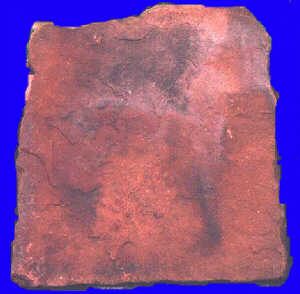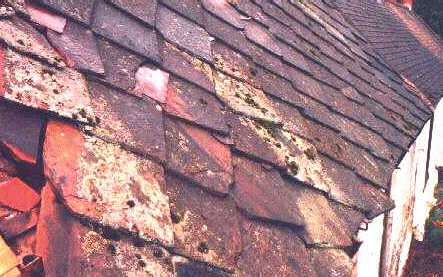| STONE ROOFING ASSOCIATION | |
| Home > Start > Contents > A Tour of the Stone Slate Regions > Permian and Triassic |
| STONE ROOFING ASSOCIATION | |
| Home > Start > Contents > A Tour of the Stone Slate Regions > Permian and Triassic |
| A TOUR OF THE STONE SLATE REGIONS | ||||||||
|
|
||||||||
| Sandstone and Magnesian Limestone from the Permian and Triassic have been used for roofing. Although Permo-Triassic sandstones are found in Devon, Cumbria and southern Scotland, stone slates appear to have only been produced in the Eden Valley of Cumbria and around Dumfries. The Magnesian Limestone which stretches from Nottingham to South Shields is only known as roofing around Whitwell in east Derbyshire. | ||||||||
| PERMO-TRIASSIC
GEOLOGY
In the Eden Valley the St Bees and Penrith Sandstones have supplied a small area roughly from Penrith to Carlisle, bounded to the east by the Pennine escarpment and extending some distance to the west where they are supplanted by the Skiddaw Slates and the Borrowdale Tuff slates. The full sequence of the Permian in the Eden Valley includes two sources of fissile sandstone: the St Bees and the Penrith. The St Bees Sandstone was formed in water environments, similarly to other roofing stones in England and is a durable masonry material. The Penrith Sandstone, in contrast was formed from desert dunes and is very variable in quality, depending on the extent of secondary cementation. |
||||||||
|
||||||||
| There are a number of quarries in the Penrith Sandstone in the Armathwaite - Lazonby Plumpton area and in the St Bees formation further east. Colloquial evidence suggests that the most durable stone slates were restricted to those between the A6 road and the River Eden at Blaze and Lazonby Fell in the Penrith Sandstone. It is likely that if any roofing came out of the St Bees it was in minor quantities. Further south, to the east of Penrith there are several quarries (one in Slatequarry Wood) which may have supplied roofing during the development of Penrith around 1800, when the local quarrying industry expanded. | ||||||||

A Penrith Sandstone from the Eden Valley Top |
||||||||
| This roofing material is locally important in the villages between the M6 and the Pennine escarpment. Armathwaite and Lazonby villages are particularly rich in these distinctive red roofs. At Fairbank Farm near Plumpton there is an outstanding and almost complete suite of buildings with the original roofs intact. | ||||||||
| Elsewhere there is evidence that the stone slates are being lost at a significant rate. In Penrith old paintings show many stone roofs but today there are few left and most only as have stone courses at the eaves. Interestingly, there are many old roofs covered with red metamorphic slates from the Cambrian belt in Wales. Presumably an early attempt to conserve the colour of the sandstone roofs as they were renovated. | ||||||||
| Outside the area bounded by the M6 to the west; the Pennine escarpment to the east and beyond Carlisle to the north and Penrith to the south, stone slates become a minor feature. Most roofs are now partly covered with substitutes, mainly local metamorphic slates, the remaining sandstone having been concentrated at the eaves or on fewer slopes. | ||||||||
| EDEN VALLEY
ROOFS
These stone slates are large. It is not unusual to find slates with a length range from about 40 inches to 18 inches. The roof design is correspondingly simply - gable to gable. Verges are normally oversailing but copings are seen occasionally either laid on the slates or raised and with lead soakers and flashings. Valleys are rare; hips less so and are covered with lead or tiles. Ridges are normally stone. Beyond the immediate quarrying area it is common to find stone slates at the eaves only. |
||||||||
| DUMFRIES
In the Dumfries region stone slates were quarried at Llocharbriggs and Lochmaben. There is a description and photographs of the Llochabriggs quarry in its heyday in Quarries of Scotland. This is a very special style of diamond shape stone roofing - unique even - and is under great threat. Only a few roofs still exist and it would be a tragedy if they too were to disappear especially as the stone from which they were originally made is still quarried. |
||||||||

The Dumfrieshire diamond style of roofing harks back to the earliest type known elsewhere from Roman sites. |
||||||||
| LOCHMABEN.
The rocks found in this parish are all of secondary formation (sedimentary) and dip to the south. The only quarry worked in the parish is of red sandstones. A very considerable portion of this rock is found in thin layers, which are easily separated, so that they are now much used in covering the roofs of houses, particularly of farmsteadings. The roof when properly put on looks neat, though some objections are made against its weight, and tendency to draw damp in winter, which is injurious to the wood. Statistical account of Scotland. Blackwood 1845 |
||||||||
| Both Eden Valley and Dumfries sandstone slates are distinctive and important and are under severe risk of disappearing entirely. Urgent action is needed to establish a source of new slates to feed into the repair cycle. | ||||||||
| See also Grinshill in Shropshire. | ||||||||
| MAGNESIAN
LIMESTONE
Although the Magnesian Limestone occurs over a narrow strip about 300 miles long in northern England it is only known as a roofing material near Whitwell in east Derbyshire and even here there are only a few roofs known. If anyone has any more information on this stone please let me know. |
|
|
|
Start |